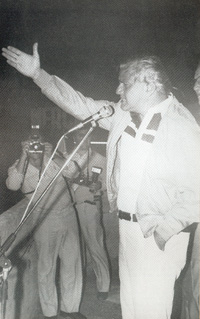Antonio Cafiero facts for kids
Quick facts for kids
Antonio Cafiero
|
|
|---|---|

Antonio Cafiero in 1988
|
|
| National Senator | |
| In office 10 December 1993 – 10 December 2005 |
|
| Constituency | Buenos Aires |
| 7th Chief of the Cabinet of Ministers | |
| In office 30 December 2001 – 2 January 2002 |
|
| President | Eduardo Camaño |
| Preceded by | Luis Lusquiños |
| Succeeded by | Jorge Capitanich |
| Governor of Buenos Aires | |
| In office 10 December 1987 – 10 December 1991 |
|
| Lieutenant | Luis María Macaya |
| Preceded by | Alejandro Armendáriz |
| Succeeded by | Eduardo Duhalde |
| Personal details | |
| Born | 12 September 1922 Buenos Aires, Argentina |
| Died | 13 October 2014 (aged 92) Buenos Aires, Argentina |
| Political party | Justicialist Party |
| Spouse | Ana Goitía |
| Alma mater | University of Buenos Aires |
| Profession | Accountant |
Antonio Francisco Cafiero (born September 12, 1922 – died October 13, 2014) was an important Argentine politician. He was a member of the Justicialist Party. Cafiero held many key jobs during his career. He was the governor of Buenos Aires Province from 1987 to 1991. He also served as the Cabinet Chief for a short time in 2001-2002. Later, he was a Senator from 1993 to 2005.
Contents
Early Life and Education
Antonio Cafiero was born in Buenos Aires, Argentina. When he was 16, he joined a group called Catholic Action in 1938. He went to the University of Buenos Aires. There, he became the leader of the Students' Association.
He finished his studies as an accountant in 1944. Later, in 1948, he earned a special degree in Economic Sciences. He also taught economics at the university for many years, from 1952 to 1984.
Cafiero became a strong supporter of Juan Perón and his political ideas, known as Peronism. This happened after a big public event on October 17, 1945. In 1952, he started working for the government. He became the Minister of Foreign Trade under President Perón until 1954. Antonio Cafiero was married to Ana Goitía. They had ten children together. Several of his children and even his grandson followed in his footsteps and became politicians.
Political Journey
Antonio Cafiero was very active in the Justicialist Party from 1962 onwards. After the Peronists returned to power in 1973, Cafiero was chosen as the Secretary of Commerce in Perón's last government in 1974.
After Perón passed away, his wife, Isabel Perón, became president. Cafiero was then appointed to lead Mendoza Province for a short time (1974–1975). He also worked as an Ambassador to the European Economic Community and Belgium in 1975. In August of that year, he became the Economy Minister. He faced many economic challenges during this period. He also briefly served as Ambassador to the Holy See before a military coup in March 1976.
Governor of Buenos Aires
In September 1982, Cafiero started a new group within the Justicialist Party. It was called the Movement for Unity, Solidarity and Organization. This group, also known as Renovación Peronista (Peronist Renewal), wanted to make changes in the party. This happened before Argentina returned to democracy in 1983.
In 1985, Cafiero was elected to the Argentine Chamber of Deputies. Then, in 1987, he became the Governor of Buenos Aires Province. He also became the head of the Justicialist Party's National Council. In 1988, he ran in the primary election to become the presidential candidate. However, he lost to Carlos Menem, who later became president in 1989.
Later Career and Public Service
In 1992, President Menem appointed Cafiero as Ambassador to Chile. The next year, in 1993, Cafiero returned to elected office as a Senator. He helped with the changes to the Argentine Constitution in 1994. These changes allowed President Menem to be re-elected.
The new Argentine Constitution gave more self-governance to the city of Buenos Aires. The city's appointed mayor was replaced by an elected mayor. Its city council was replaced by the Buenos Aires City Legislature. However, Senator Cafiero helped pass a law, known as Ley Cafiero (the "Cafiero Law"), in 1996. This law limited some of the city's power. For example, it kept control of the police and the Port of Buenos Aires with the national government. This law has been a topic of discussion between presidents and Buenos Aires mayors ever since.
Cafiero was re-elected as Senator in 2001. He briefly took a break from the Senate to serve as Cabinet Chief under interim president Eduardo Camaño from 2001 to 2002. He then returned to the Senate and retired in 2005. From 2005 to 2011, Cafiero was the President of COPPPAL. This is a group for political parties in Latin America and the Caribbean.
Antonio Cafiero passed away on October 13, 2014, in Buenos Aires.
See also
 In Spanish: Antonio Cafiero para niños
In Spanish: Antonio Cafiero para niños


